2020 Hyundai Tucson brake
[x] Cancel search: brakePage 514 of 637

6-26
What to do in an emergency
If a towing service is not available in
an emergency, your vehicle may be
temporarily towed using a cable or
chain secured to the emergency tow-
ing hook at the front (or rear) of the
vehicle.
Use extreme caution when towing
the vehicle with a cable or chain. A
driver must be in the vehicle to steer
it and operate the brakes.
Towing in this manner may be done
only on hard-surfaced roads for a
short distance and at low speeds.
Also, the wheels, axles, power train,
steering and brakes must all be in
good condition.Always follow these emergency tow-
ing precautions:
Place the ignition switch in the
ACC position so the steering wheel
is not locked.
Place the shift lever in N (Neutral).
Release the parking brake.
Depress the brake pedal with more
force than normal since you will
have reduced braking perform-
ance.
More steering effort will be
required because the power steer-
ing system will be disabled.
Use a vehicle heavier than your
own to tow your vehicle.
The drivers of both vehicles should
communicate with each other fre-
quently.
Before emergency towing, check
that the hook is not broken or dam-
aged.
Fasten the towing cable or chain
securely to the hook.
Do not jerk the hook. Apply a
steady and even force. Use a towing cable or chain less
than 5 m long. Attach a white or red
cloth (about 30 cm wide) in the
middle of the cable or chain for
easy visibility.
Drive carefully so the towing cable
or chain remains tight during tow-
ing.
Before towing, check the automat-
ic transmission/dual clutch trans-
mission for fluid leaks under your
vehicle. If the automatic transmis-
sion fluid is leaking, flatbed equip-
ment or a towing dolly must be
used.
OTLE068029
The driver must be in the vehi-
cle for steering and braking
operations when the vehicle is
being towed. Passengers other
than the driver must not be in
the vehicle.
CAUTION
Page 517 of 637
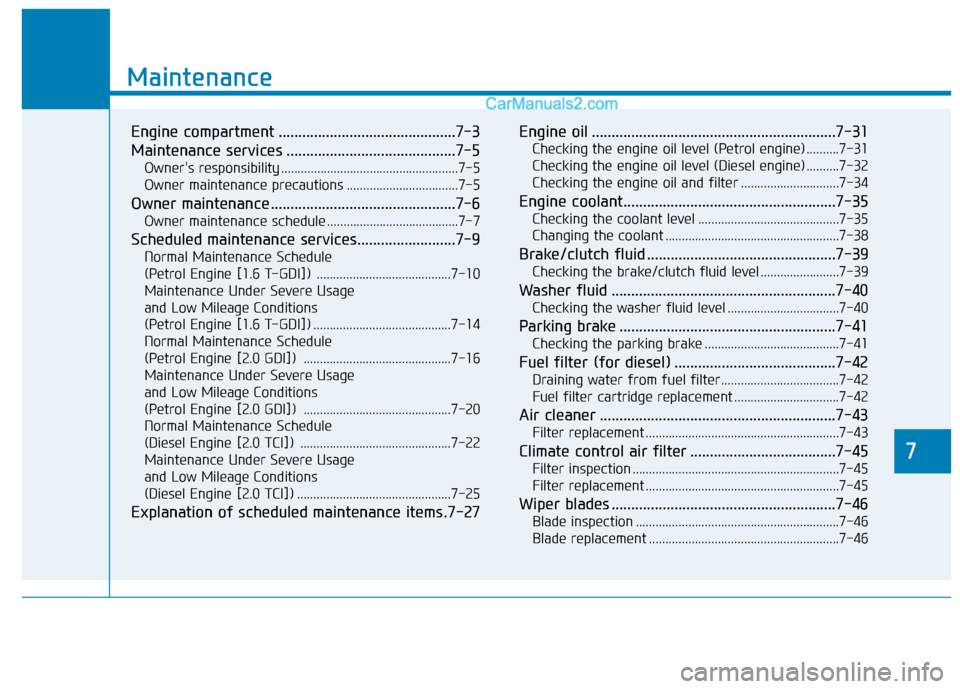
7
Maintenance
7
Maintenance
Engine compartment .............................................7-3
Maintenance services ...........................................7-5
Owner's responsibility ......................................................7-5
Owner maintenance precautions ..................................7-5
Owner maintenance ...............................................7-6
Owner maintenance schedule ........................................7-7
Scheduled maintenance services.........................7-9
Normal Maintenance Schedule
(Petrol Engine [1.6 T-GDI]) .........................................7-10
Maintenance Under Severe Usage
and Low Mileage Conditions
(Petrol Engine [1.6 T-GDI]) ..........................................7-14
Normal Maintenance Schedule
(Petrol Engine [2.0 GDI]) .............................................7-16
Maintenance Under Severe Usage
and Low Mileage Conditions
(Petrol Engine [2.0 GDI]) .............................................7-20
Normal Maintenance Schedule
(Diesel Engine [2.0 TCI]) ..............................................7-22
Maintenance Under Severe Usage
and Low Mileage Conditions
(Diesel Engine [2.0 TCI]) ...............................................7-25
Explanation of scheduled maintenance items .7-27Engine oil ..............................................................7-31
Checking the engine oil level (Petrol engine) ..........7-31
Checking the engine oil level (Diesel engine) ..........7-32
Checking the engine oil and filter ..............................7-34
Engine coolant......................................................7-35
Checking the coolant level ...........................................7-35
Changing the coolant .....................................................7-38
Brake/clutch fluid ................................................7-39
Checking the brake/clutch fluid level ........................7-39
Washer fluid .........................................................7-40
Checking the washer fluid level ..................................7-40
Parking brake .......................................................7-41
Checking the parking brake .........................................7-41
Fuel filter (for diesel) .........................................7-42
Draining water from fuel filter ....................................7-42
Fuel filter cartridge replacement ................................7-42
Air cleaner ............................................................7-43
Filter replacement ...........................................................7-43
Climate control air filter .....................................7-45
Filter inspection ...............................................................7-45
Filter replacement ...........................................................7-45
Wiper blades .........................................................7-46
Blade inspection ..............................................................7-46
Blade replacement ..........................................................7-46
7
Page 519 of 637
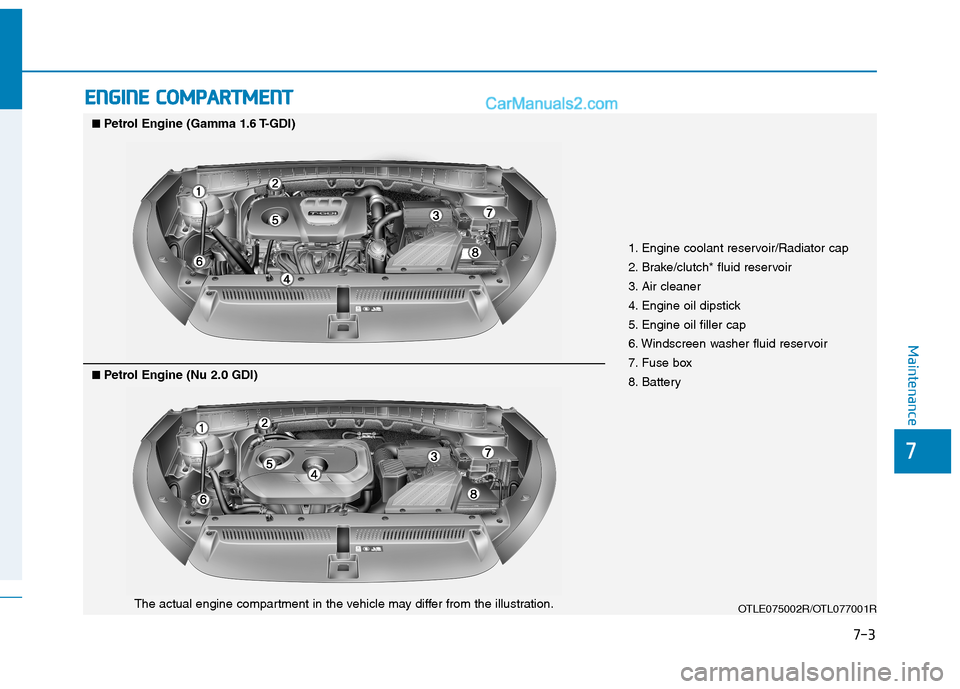
7-3
7
Maintenance
E EN
NG
GI
IN
NE
E
C
CO
OM
MP
PA
AR
RT
TM
ME
EN
NT
T
1. Engine coolant reservoir/Radiator cap
2. Brake/clutch* fluid reservoir
3. Air cleaner
4. Engine oil dipstick
5. Engine oil filler cap
6. Windscreen washer fluid reservoir
7. Fuse box
8. Battery
OTLE075002R/OTL077001R
■ ■Petrol Engine (Nu 2.0 GDI)
The actual engine compartment in the vehicle may differ from the illustration.
■ ■Petrol Engine (Gamma 1.6 T-GDI)
Page 520 of 637

7-4
Maintenance
1. Engine coolant reservoir/Radiator cap
2. Brake/clutch* fluid reservoir
3. Air cleaner
4. Engine oil dipstick
5. Engine oil filler cap
6. Windscreen washer fluid reservoir
7. Fuse box
8. Battery
9. Fuel filter
* : if equipped
OTLE078001RThe actual engine compartment in the vehicle may differ from the illustration.
■ ■Diesel Engine (R 2.0 TCI)
Page 522 of 637
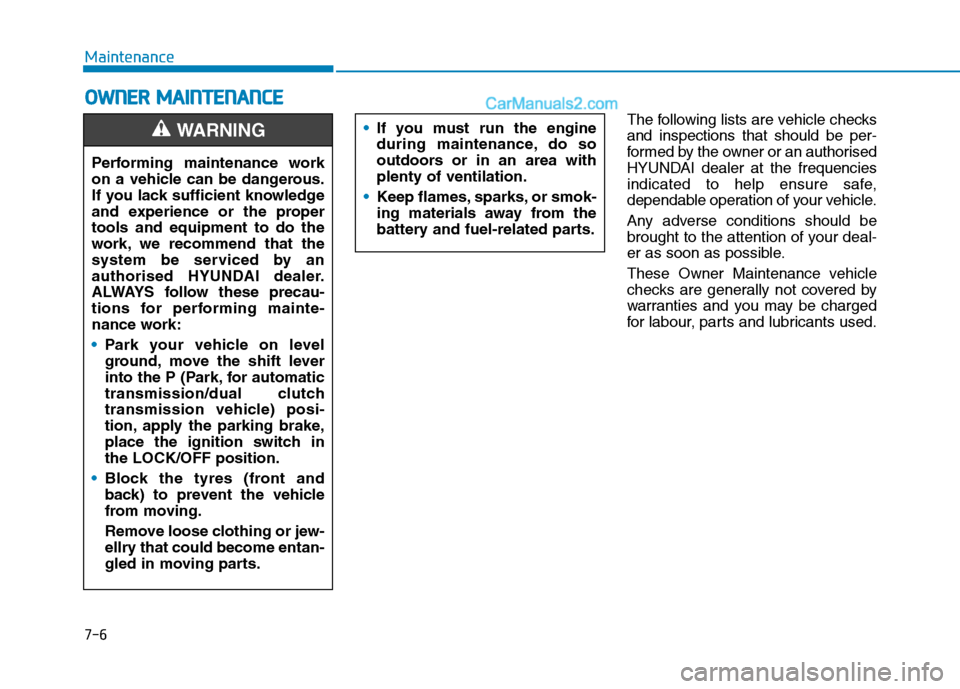
7-6
Maintenance
O OW
WN
NE
ER
R
M
MA
AI
IN
NT
TE
EN
NA
AN
NC
CE
E
The following lists are vehicle checks
and inspections that should be per-
formed by the owner or an authorised
HYUNDAI dealer at the frequencies
indicated to help ensure safe,
dependable operation of your vehicle.
Any adverse conditions should be
brought to the attention of your deal-
er as soon as possible.
These Owner Maintenance vehicle
checks are generally not covered by
warranties and you may be charged
for labour, parts and lubricants used. Performing maintenance work
on a vehicle can be dangerous.
If you lack sufficient knowledge
and experience or the proper
tools and equipment to do the
work, we recommend that the
system be serviced by an
authorised HYUNDAI dealer.
ALWAYS follow these precau-
tions for performing mainte-
nance work:
Park your vehicle on level
ground, move the shift lever
into the P (Park, for automatic
transmission/dual clutch
transmission vehicle) posi-
tion, apply the parking brake,
place the ignition switch in
the LOCK/OFF position.
Block the tyres (front and
back) to prevent the vehicle
from moving.
Remove loose clothing or jew-
ellry that could become entan-
gled in moving parts.WARNING If you must run the engine
during maintenance, do so
outdoors or in an area with
plenty of ventilation.
Keep flames, sparks, or smok-
ing materials away from the
battery and fuel-related parts.
Page 523 of 637
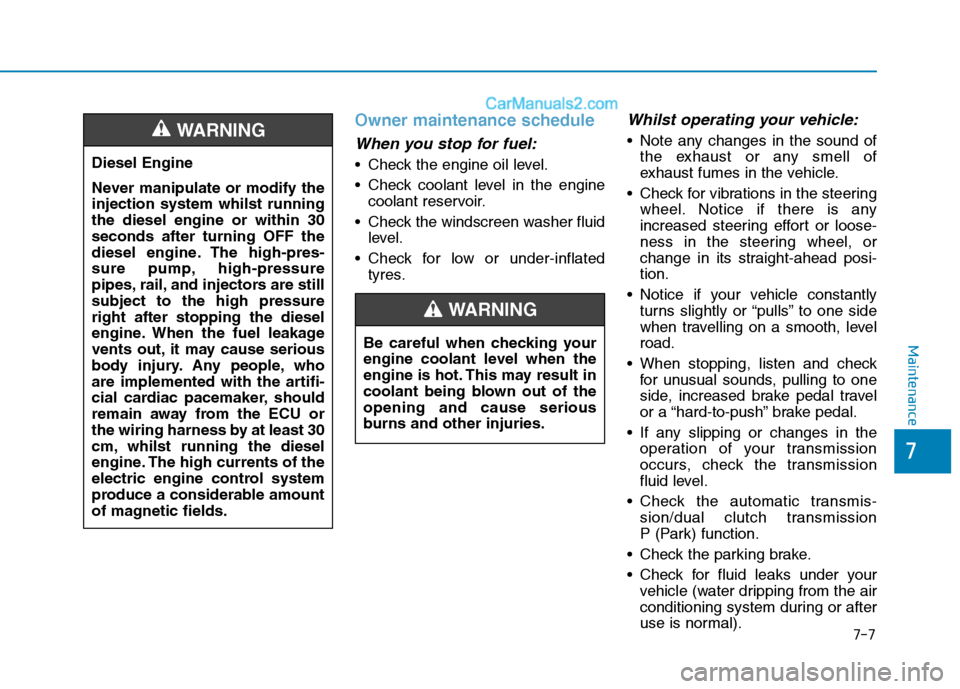
7-7
7
Maintenance
Owner maintenance schedule
When you stop for fuel:
Check the engine oil level.
Check coolant level in the engine
coolant reservoir.
Check the windscreen washer fluid
level.
Check for low or under-inflated
tyres.
Whilst operating your vehicle:
Note any changes in the sound of
the exhaust or any smell of
exhaust fumes in the vehicle.
Check for vibrations in the steering
wheel. Notice if there is any
increased steering effort or loose-
ness in the steering wheel, or
change in its straight-ahead posi-
tion.
Notice if your vehicle constantly
turns slightly or “pulls” to one side
when travelling on a smooth, level
road.
When stopping, listen and check
for unusual sounds, pulling to one
side, increased brake pedal travel
or a “hard-to-push” brake pedal.
If any slipping or changes in the
operation of your transmission
occurs, check the transmission
fluid level.
Check the automatic transmis-
sion/dual clutch transmission
P (Park) function.
Check the parking brake.
Check for fluid leaks under your
vehicle (water dripping from the air
conditioning system during or after
use is normal). Be careful when checking your
engine coolant level when the
engine is hot. This may result in
coolant being blown out of the
opening and cause serious
burns and other injuries.
WARNING
Diesel Engine
Never manipulate or modify the
injection system whilst running
the diesel engine or within 30
seconds after turning OFF the
diesel engine. The high-pres-
sure pump, high-pressure
pipes, rail, and injectors are still
subject to the high pressure
right after stopping the diesel
engine. When the fuel leakage
vents out, it may cause serious
body injury. Any people, who
are implemented with the artifi-
cial cardiac pacemaker, should
remain away from the ECU or
the wiring harness by at least 30
cm, whilst running the diesel
engine. The high currents of the
electric engine control system
produce a considerable amount
of magnetic fields.
WARNING
Page 524 of 637
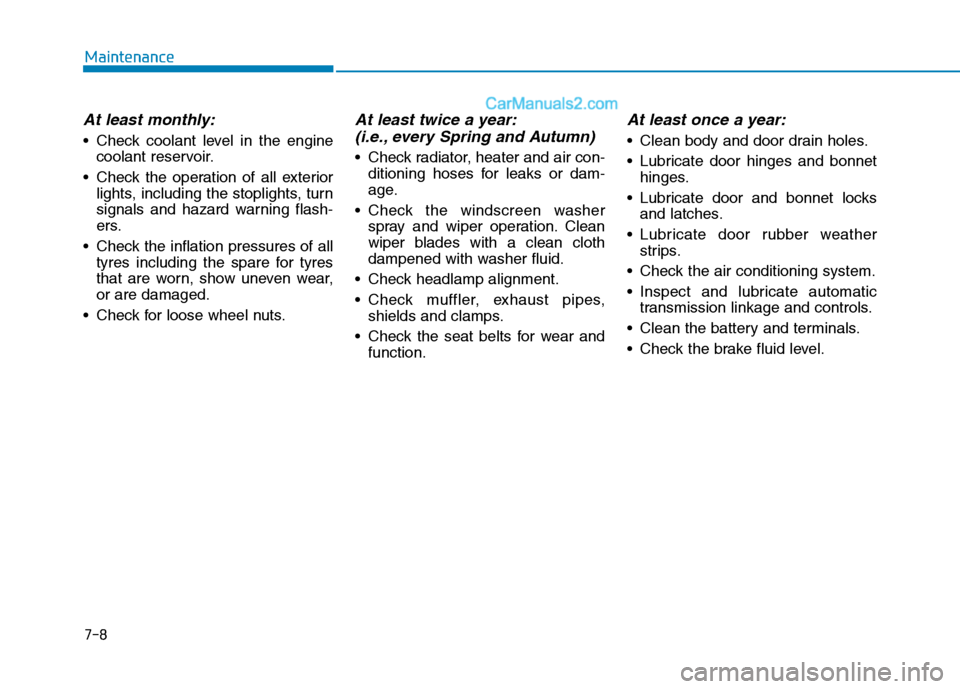
7-8
Maintenance
At least monthly:
Check coolant level in the engine
coolant reservoir.
Check the operation of all exterior
lights, including the stoplights, turn
signals and hazard warning flash-
ers.
Check the inflation pressures of all
tyres including the spare for tyres
that are worn, show uneven wear,
or are damaged.
Check for loose wheel nuts.
At least twice a year:
(i.e., every Spring and Autumn)
Check radiator, heater and air con-
ditioning hoses for leaks or dam-
age.
Check the windscreen washer
spray and wiper operation. Clean
wiper blades with a clean cloth
dampened with washer fluid.
Check headlamp alignment.
Check muffler, exhaust pipes,
shields and clamps.
Check the seat belts for wear and
function.
At least once a year:
Clean body and door drain holes.
Lubricate door hinges and bonnet
hinges.
Lubricate door and bonnet locks
and latches.
Lubricate door rubber weather
strips.
Check the air conditioning system.
Inspect and lubricate automatic
transmission linkage and controls.
Clean the battery and terminals.
Check the brake fluid level.
Page 527 of 637
![Hyundai Tucson 2020 Owners Manual - RHD (UK, Australia) 7-11
7
Maintenance
Normal Maintenance Schedule (Petrol Engine [1.6 T-GDI]) (Cont.)
Months1224364860728496
Km x 1,0001020304050607080
Fuel filter *6R
Fuel line, hoses and connectionsI
Cooling system
In Hyundai Tucson 2020 Owners Manual - RHD (UK, Australia) 7-11
7
Maintenance
Normal Maintenance Schedule (Petrol Engine [1.6 T-GDI]) (Cont.)
Months1224364860728496
Km x 1,0001020304050607080
Fuel filter *6R
Fuel line, hoses and connectionsI
Cooling system
In](/manual-img/35/19693/w960_19693-526.png)
7-11
7
Maintenance
Normal Maintenance Schedule (Petrol Engine [1.6 T-GDI]) (Cont.)
Months1224364860728496
Km x 1,0001020304050607080
Fuel filter *6R
Fuel line, hoses and connectionsI
Cooling system
Inspect coolant level for leaks every day
At first, inspect 40,000 km or 48 months :
after that, inspect every 20,000 km or 24 months
Engine coolant *7At first, replace at 210,000 km or 120 months :
after that, replace every 30,000 km or 24 months *5
All electrical systemsIIIIIIII
Battery conditionIIIIIIII
Brake lines, hoses and connectionsIIIIIIII
Brake pedal, Clutch pedal (if equipped)II
MAINTENANCE
INTERVALS
MAINTENANCE
ITEM
I : Inspect and if necessary, adjust, correct, clean or replace.
R : Replace or change.
*
5: For your convenience, it can be replaced prior to it's interval when you do maintenance of other items.
*6: The fuel filter is considered to be maintenance free but periodic inspection is recommended for this maintenance schedule
depending on fuel quality. If there are some important matters like fuel flow restriction, surging, loss of power, or hard starting
problems etc, we recommend replacing the fuel filter immediately regardless of maintenance schedule and consulting with an
authorised HYUNDAI dealer for details.
*
7: When adding coolant, use only deionised water or soft water for your vehicle and never mix hard water in the coolant filled at
the factory. An improper coolant mixture can result in serious malfunction or engine damage. For your convenience, it can bere-
placed prior to it's interval when you do maintenance of other items.